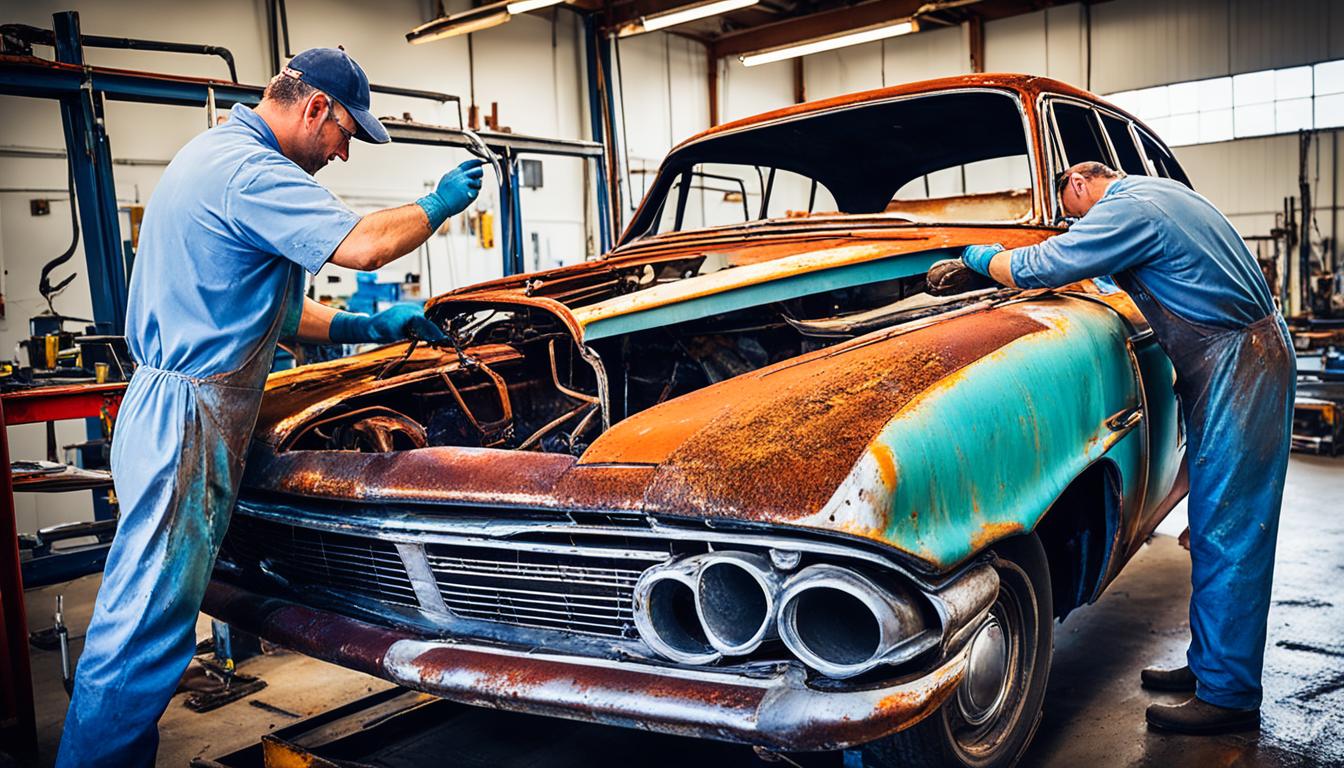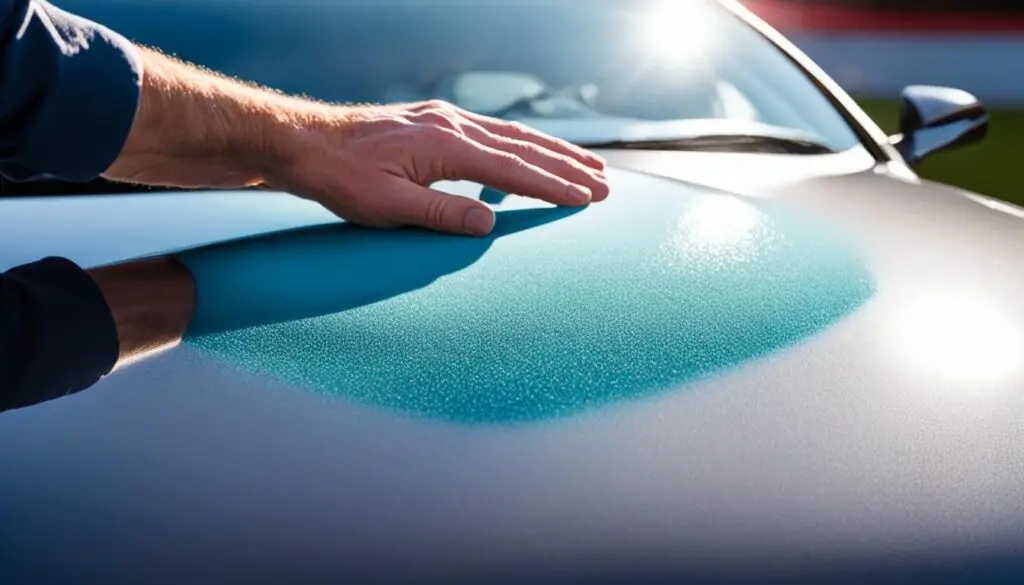
Bringing Cars Back to Life: The Art of Automotive Paint Restoration
Restoring original paint on classic and antique cars is loved in the collector car world. It helps maintain the car’s value and history. Yet, old single stage paints often face oxidation, making them look dull or chalky. To fix this, experts have to carefully strip off the old layers without touching the good paint.
Metallic paints have their own set of challenges. The aluminum flakes they contain can also oxidize. This makes restoring them tricky. The paint’s thinness, fragility, and how soft it is, adds to the difficulty.
Key Takeaways:
- Restoring the original paint on classic and antique cars adds value and maintains the overall originality of the vehicle.
- Single stage paints, commonly found on older cars, are prone to oxidation which deteriorates the paint’s appearance.
- Removing oxidized paint requires caution to avoid removing excessive amounts of paint.
- Restoring single stage metallic paints can be more challenging due to oxidation of the aluminum flakes.
- Restoring antique and original paint requires careful consideration due to thinness, fragility, and softness of the paint layers.
The Process of Automotive Paint Correction
Paint correction is a detailed car care technique. It works to make a vehicle’s paint look new. This is vital because a car’s paint can get ruined over time. It may have swirl marks, scratches, and more. These not only make the car look bad but also harm the paint’s protection.
The first step in paint correction is to check the paint’s condition. Then, the surface is cleaned and prepared. After that, the car’s paint goes through compounding, polishing, and finishing steps.
- Assessment: Checking the paint is the first step. Experts review the paint’s scratches, swirls, and oxidation depth.
- Surface Preparation: Before anything else, the surface must be spotless. It’s washed to get rid of any dirt or grime.
- Compounding: This step uses cutting compounds and a polisher to remove defects. It also makes the paint surface even. The compounds have tiny abrasive pieces that smooth the paint.
- Polishing: After compounding, a polishing step is done. It’s to make the paint shine. This also gets rid of any marks left from compounding.
- Finishing: A high-quality wax or sealant is then applied. This protects the paint from dirt, UV rays, and more. It makes the correction last longer.
Paint correction is not just about fixing damage. It makes the car’s color look more vibrant too. And it protects the paint from the outside world. Plus, it could raise the car’s resale value.

Professional Paint Restoration: The Expert’s Touch
Professional car detailers are the best choice for fixing automotive paint. They need the right tools and lots of knowledge. Professional car paint restoration is like art that you learn over years.
In Seattle, the weather can harm your car’s paint. Getting professional paint correction here is a wise move. These experts know what your vehicle needs to fight the weather and look its best.
Paint correction makes a car look much better. But, it can’t fix very old or damaged paint. Yet, an old car with a unique worn look can be beautiful. So, your paint restoration decision should match your taste and the look you want for your car.
Taking care of an old or special car’s paint needs skill. Trusting professional car detailers ensures top-notch work. Don’t risk your car’s look with DIY. Choose skilled detailers to make your car’s paint shine.
FAQ
What is automotive paint restoration?
Automotive paint restoration brings back the original paint on old cars. It aims to keep the car looking like it did originally. This process removes dullness and restores the color and shine of the paint.
What causes oxidation on single stage paints?
Over time, single stage paints on older cars can oxidize. This leads to the paint looking chalky or whitish.
How can I restore the paint on my antique car without removing too much paint?
Use gentle products and techniques to keep as much original paint as possible. This approach avoids removing too much paint. It’s an important strategy for antique cars.
Why are single stage metallic paints more difficult to restore?
Single stage metallic paints contain aluminum flakes. When these flakes oxidize, the paint gets harder to restore. This can make the restoration job tougher.
What is paint correction?
Paint correction is a car detailing technique. It makes the car’s paint look new by removing scratches and dull spots. It’s about taking the paint back to its best condition.
What is involved in the process of paint correction?
The paint correction process starts by checking the paint’s condition. It goes on with preparing the surface, then compounding and polishing. At the end, the car receives a protective finish.
Can I attempt DIY paint correction?
DIY paint correction is doable, but it’s not easy. It needs skill, the right tools, and knowledge. Experts know how to fix your car’s paint without risking damage.
Why should I invest in professional paint correction in Seattle?
Seattle’s weather can be hard on cars. Professional paint correction in Seattle protects your car better. It gives you a top-notch finish that fights against the elements.
Can paint correction completely restore heavily oxidized or damaged paint?
Paint correction can do a lot to improve old paint jobs. However, it might not fully fix very damaged or oxidized paint. Its success depends on the paint’s condition.
Should I pursue paint restoration for a car with patina?
Deciding to restore paint on a patina car is personal. Patina gives a car a unique look. So, before restoring, consider if you enjoy this look.
Source Links
- https://www.autogeekonline.net/forum/how-to-articles/25304-secret-removing-oxidation-restoring-show-car-finish-antique-single-stage-paints.html
- https://bigsmobile.com/blog/the-art-of-paint-correction-restoring-your-cars-shine/
- https://ask.metafilter.com/49693/What-is-the-best-way-to-restore-hazy-car-paint-from-the-70s
